All about marbled Bengal cats
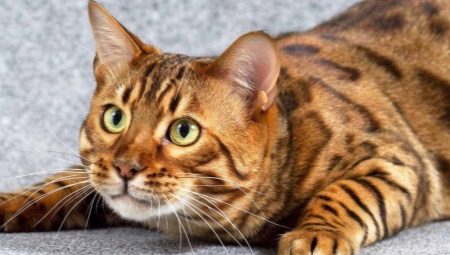
At the end of the 20th century, genetic biologist Jean Mill began work on the selection of a wild Asian cat and a domestic one. The animal received a leopard color from wild progenitors. Over the years (since the student days), work has been carried out to improve the qualities of a pet. This work was crowned with success. A new breed has appeared - the Bengal marble cat.

Peculiarities
Felinologists initially did not accept this breed, but in 1991 they had to give up. Some communities of cat lovers still do not accept this hybrid, but in vain. The marbled Bengal cat received only the best qualities from its ancestors.
She combines friendliness, affection of a domestic cat and playfulness of a kitty, grace, plasticity and hunter's instinct.

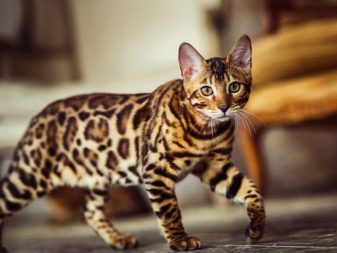
Description
These animals grow to large sizes. Cats quickly gain weight over 6 kilograms. Bengals are independent, independent, love water, unlike other domestic cats. The head of the animals of this breed is heavy and large, similar to that of a tiger. Square shaped pillows. The base of the ears is necessarily wide, the ears themselves are high, inclined forward. This breed has almond-shaped, expressive eyes. And when the animal follows the prey, they turn into the ruthless eyes of a predator.
Any color is allowed except aquamarine and blue... Only the Snow Bengal has blue eyes. These cats are shorthaired. Ironing a Bengal is a great way to get rid of stress. The coat is silky and shiny.
The World Exhibition System allows 6 colors of the Bengal breed. In Bengals, the front legs are large, thick, and the hind legs are longer than the front. The tails are most often dropped; Bengals never lift their tail up.
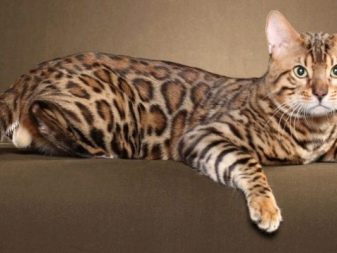

Marble Bengal cats are wonderful companions. If you do not devote time to them, then they become nervous, aggressive. This animal requires constant attention of the owner, responds with affection, devotion. This is a breed of talkative cats, participants in children's games. Bengals are non-aggressive, friendly and patient with children. They are also smart and clean.
The maintenance of this breed will require money and time from the owner.
Color
This breed has colors, both corresponding to the standards of the world cat association, and not. The first category includes colors:
- brown (gold);
- snow;
- silver.
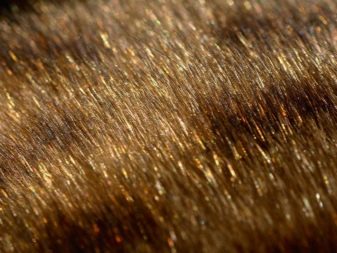
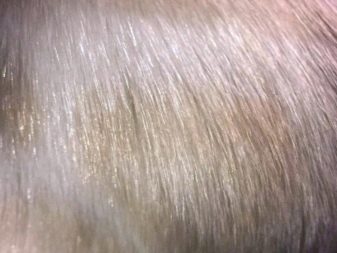
Non-standard colors:
- carbonic;
- blue;
- black.
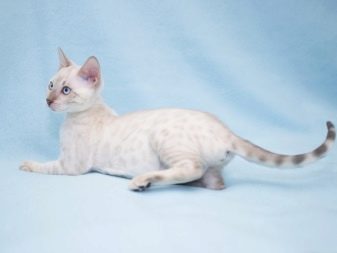



In addition, there are two more types of Bengal wool color - spotted and marbled.... The most popular color of the Bengal cat is spotted. The spots should contrast with the main color of the cat. When the spots are two tones, they are called rosettes. Outlets are the prerogative of wild animals but the Bengal domestic cat is the only animal with such a complex color.
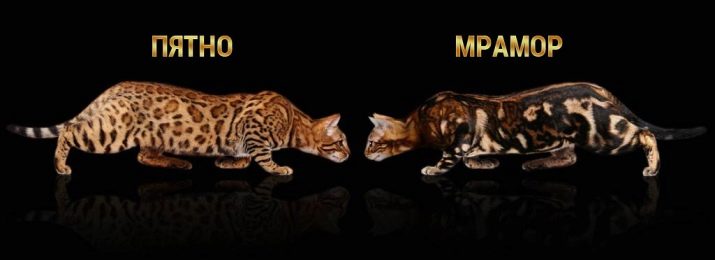
Sockets are presented in only three types:
- arrow - elongated spot with a dark tip;
- paw print - a light spot with contrasting "blots" on the sides;
- donut - a large spot, framed by a dark contrasting stripe.
The rarest type of color is marble. Present at show cats. Breeders take care of the purity of the breed, there are clear rules and regulations for this breed at shows. The marbled color is swirling stripes on the coat. There should be an asymmetric current structure of stripes of two or more colors, contrasting with the main color.
At the end of the 20th century, the first Bengal marbled kitten appeared in the cattery. This event created a stunning sensation among the audience. In 1993, the marbled color of Bengal cats was included in the status of the International Cat Association Championship. The marbled Bengal cat is different from the spotted one, sometimes it can be mistaken for a different breed. Another remarkable color - marble on gold - is highly appreciated at exhibitions. This color cannot be guessed at the birth of a kitten. It is formed in an animal by the age of two.
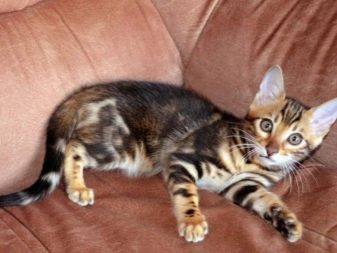

A rare color of Bengal cats - marble on silver. The fur of the cat has a light silver tone, and the pattern is sustained in dark gray or black tones. Can be found in Bengals and gray-beige color. This is when the marbled silver contrasts with the main color of the animal.
It should be noted that achieving a marbled color is not easy. The pedigree of the parents should be flawless.
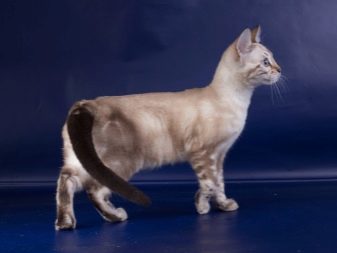
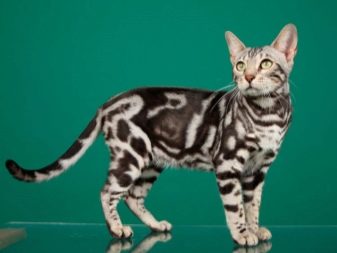
Another rare exhibition specimen of the Bengal marble cat is the Snow Bengal. This breed is allowed blue eyes. The types of color are as follows:
- sepia - golden base color with dark brown stripes;
- minx - a creamy base color with a light brown pattern;
- links - ivory, marble pattern, darker than the main one.
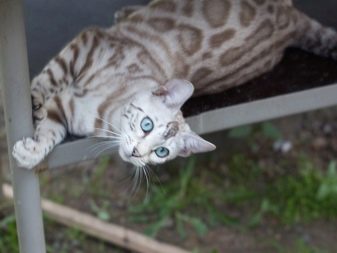

Snow Bengal kittens are born completely white. In the second year of life, a pattern on their wool begins to appear. At birth, the color of the kittens does not match the breed. At 8 months, the wool is dyed in a color that meets the standards.
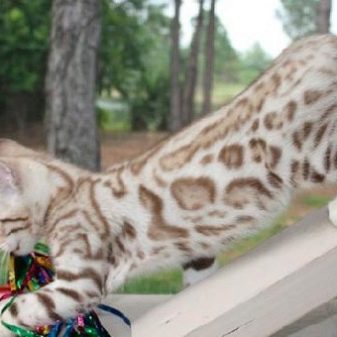

Breed traits and content
The distinctive features of the breed include color, body structure. Bengals love to swim and are not afraid of water. Although they took a lot from wild cats, it is still not recommended to keep Bengals outside. These are animals bred for home keeping. Since the breed appeared as a result of selection, it is susceptible to genetic diseases:
- heart diseases;
- improper chest structure;
- general underdevelopment;
- problems with the hip joint;
- kidney disease;
- retinal problems.
When choosing a pet for yourself, you should study the pedigree of the parents. Disorders with the health and development of kittens can also be seen visually.
If the animal is purchased for further breeding of the breed and participation in exhibitions, then cash costs will be required. Participation in the exhibition can cost from 3.5 to 4 thousand rubles. It is necessary to monitor the hair of the animal, to ensure proper balanced nutrition. In the diet of Bengal cats, raw meat should be present. Correctly trim the nails, comb the coat, monitor the health of the pet. Obligatory purchase of scratching posts and all kinds of toys.
Additional signs of the breed are the restlessness and activity of cats. We can say that they are hyperactive.
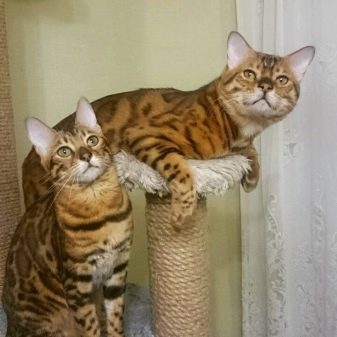

For a companion, this breed is suitable in all respects. Bengals are playful, friendly with children. They have short hair, which will not cause problems with cleaning. They get used to the toilet quickly... You need to buy a tray with high sides, as animals like to bury the "result of their labor" deeply.


As an anti-stress - this breed is number one. To get pedigree offspring, you need a cat purchased from a cattery. It is advisable to carefully study the pedigree, documents for registration of the breed. The price of mating in Russia is high, since this business has just begun to develop, and there are few cats open for mating. The average price for a thoroughbred Bengal is 25 thousand rubles. Marbled Bengal kittens cannot be cheaper.
If kittens are offered at a low cost, it means that they have errors in the pedigree, the kitten was taken away from the cat early, which is unacceptable, vaccinations and veterinary checks have not been made. The profitability of breeding this breed can only be thought of in large cities of Russia, where there is a demand for a unique breed.
Video about the breed of marbled Bengal cats, see below.
































